Economic and Strategic Analysis of Clipper Bay Tourism Development
VerifiedAdded on 2020/04/07
|14
|3486
|57
Report
AI Summary
This report addresses the economic revitalization of Clipper Bay, a remote peninsula, through the development of a sustainable tourism industry. The paper begins with a background of Clipper Bay, highlighting its current economic limitations and strategic advantages, including its geographical features (beaches, limestone caves, and hills) and human resources. The core of the report focuses on strategic approaches to tourism development, including leveraging existing resources, engaging community members, and attracting investors. It also explores the economic, socio-cultural, and environmental impacts of the proposed tourism initiatives, considering potential challenges such as infrastructure development, environmental degradation, and the need for skilled labor. The report emphasizes the importance of community involvement, environmental protection, and the development of a destination management plan to ensure the long-term sustainability and success of the tourism industry in Clipper Bay. The report also includes economic analysis, discussing the benefits and drawbacks of tourism, such as job creation, economic diversification, and infrastructure improvements.
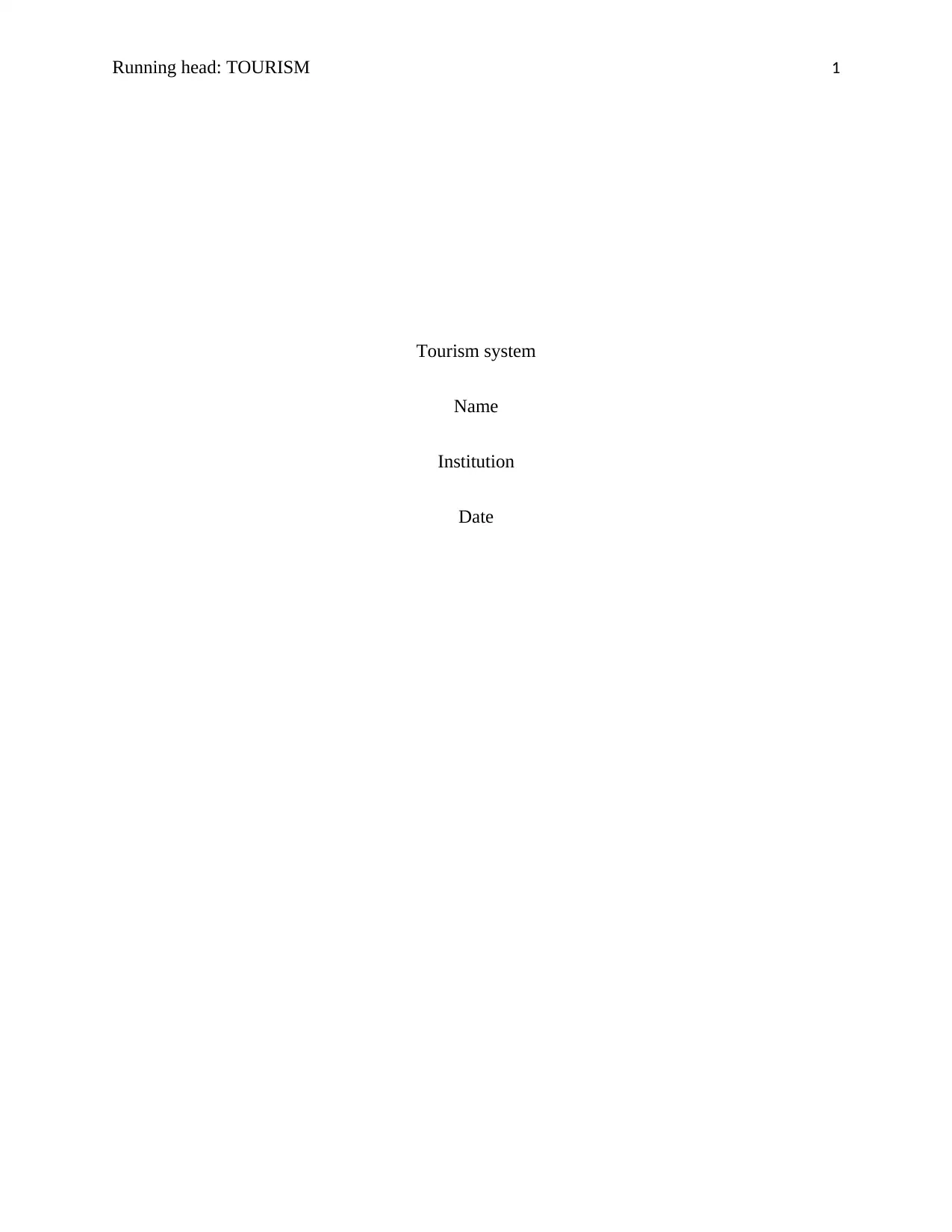
Running head: TOURISM 1
Tourism system
Name
Institution
Date
Tourism system
Name
Institution
Date
Paraphrase This Document
Need a fresh take? Get an instant paraphrase of this document with our AI Paraphraser
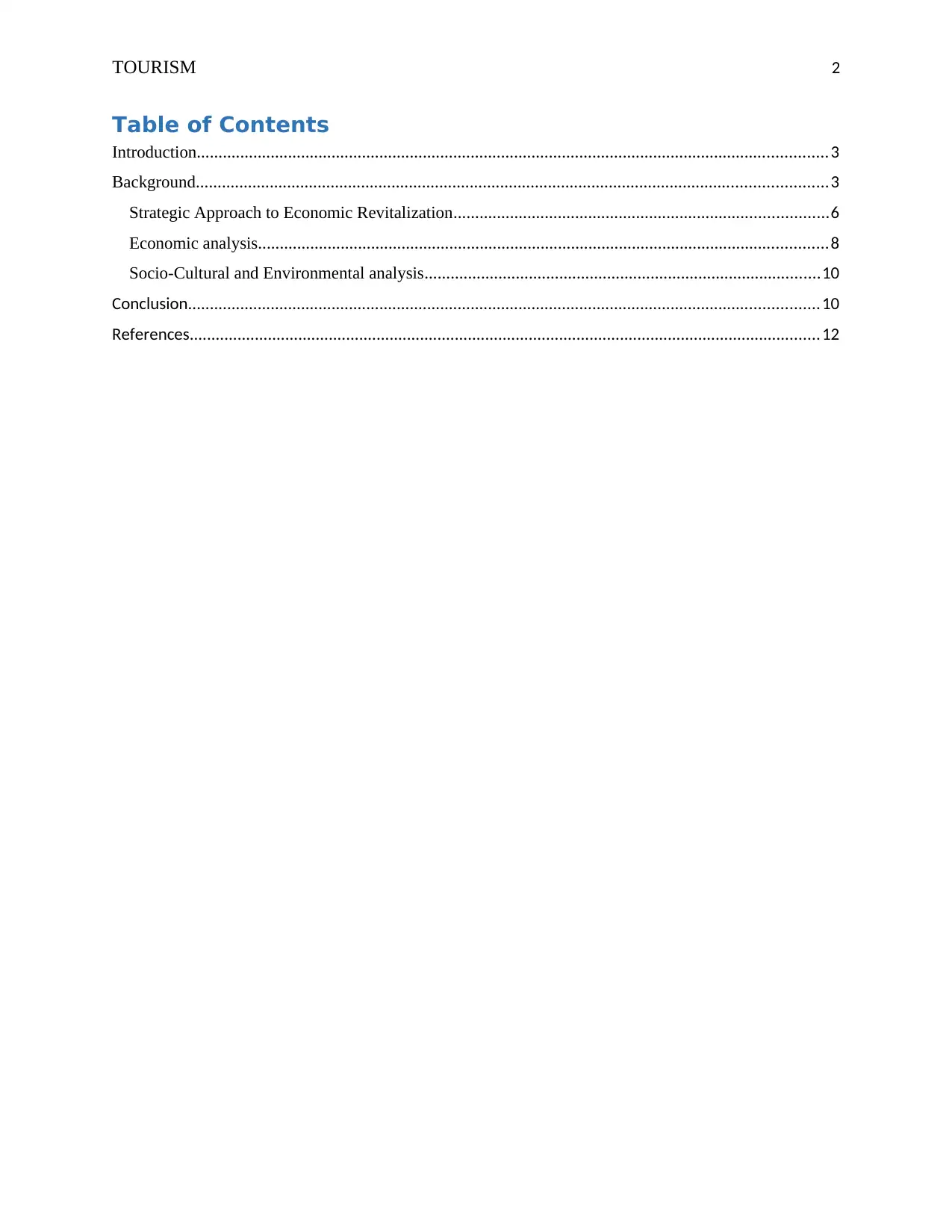
TOURISM 2
Table of Contents
Introduction.................................................................................................................................................3
Background.................................................................................................................................................3
Strategic Approach to Economic Revitalization......................................................................................6
Economic analysis...................................................................................................................................8
Socio-Cultural and Environmental analysis...........................................................................................10
Conclusion.................................................................................................................................................10
References.................................................................................................................................................12
Table of Contents
Introduction.................................................................................................................................................3
Background.................................................................................................................................................3
Strategic Approach to Economic Revitalization......................................................................................6
Economic analysis...................................................................................................................................8
Socio-Cultural and Environmental analysis...........................................................................................10
Conclusion.................................................................................................................................................10
References.................................................................................................................................................12
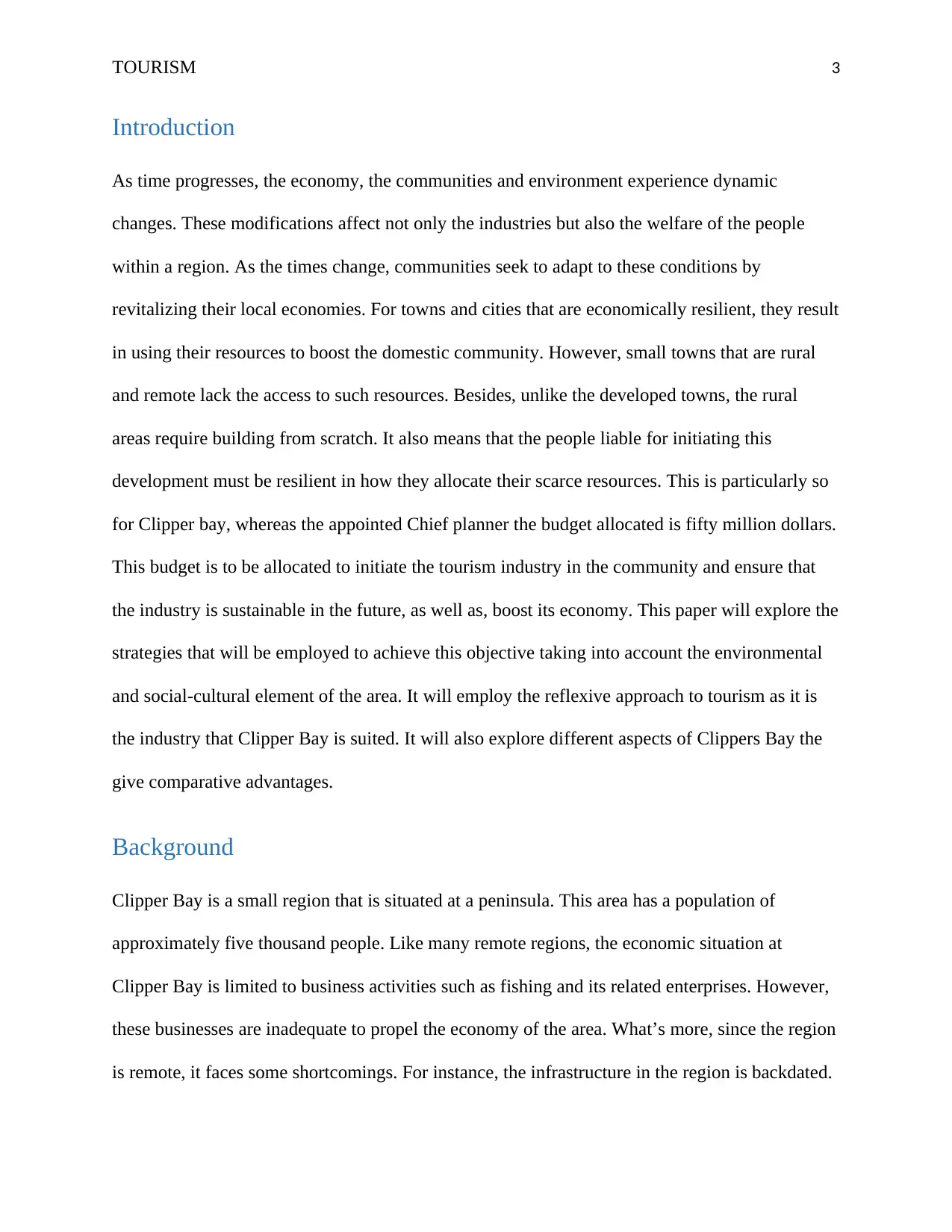
TOURISM 3
Introduction
As time progresses, the economy, the communities and environment experience dynamic
changes. These modifications affect not only the industries but also the welfare of the people
within a region. As the times change, communities seek to adapt to these conditions by
revitalizing their local economies. For towns and cities that are economically resilient, they result
in using their resources to boost the domestic community. However, small towns that are rural
and remote lack the access to such resources. Besides, unlike the developed towns, the rural
areas require building from scratch. It also means that the people liable for initiating this
development must be resilient in how they allocate their scarce resources. This is particularly so
for Clipper bay, whereas the appointed Chief planner the budget allocated is fifty million dollars.
This budget is to be allocated to initiate the tourism industry in the community and ensure that
the industry is sustainable in the future, as well as, boost its economy. This paper will explore the
strategies that will be employed to achieve this objective taking into account the environmental
and social-cultural element of the area. It will employ the reflexive approach to tourism as it is
the industry that Clipper Bay is suited. It will also explore different aspects of Clippers Bay the
give comparative advantages.
Background
Clipper Bay is a small region that is situated at a peninsula. This area has a population of
approximately five thousand people. Like many remote regions, the economic situation at
Clipper Bay is limited to business activities such as fishing and its related enterprises. However,
these businesses are inadequate to propel the economy of the area. What’s more, since the region
is remote, it faces some shortcomings. For instance, the infrastructure in the region is backdated.
Introduction
As time progresses, the economy, the communities and environment experience dynamic
changes. These modifications affect not only the industries but also the welfare of the people
within a region. As the times change, communities seek to adapt to these conditions by
revitalizing their local economies. For towns and cities that are economically resilient, they result
in using their resources to boost the domestic community. However, small towns that are rural
and remote lack the access to such resources. Besides, unlike the developed towns, the rural
areas require building from scratch. It also means that the people liable for initiating this
development must be resilient in how they allocate their scarce resources. This is particularly so
for Clipper bay, whereas the appointed Chief planner the budget allocated is fifty million dollars.
This budget is to be allocated to initiate the tourism industry in the community and ensure that
the industry is sustainable in the future, as well as, boost its economy. This paper will explore the
strategies that will be employed to achieve this objective taking into account the environmental
and social-cultural element of the area. It will employ the reflexive approach to tourism as it is
the industry that Clipper Bay is suited. It will also explore different aspects of Clippers Bay the
give comparative advantages.
Background
Clipper Bay is a small region that is situated at a peninsula. This area has a population of
approximately five thousand people. Like many remote regions, the economic situation at
Clipper Bay is limited to business activities such as fishing and its related enterprises. However,
these businesses are inadequate to propel the economy of the area. What’s more, since the region
is remote, it faces some shortcomings. For instance, the infrastructure in the region is backdated.
⊘ This is a preview!⊘
Do you want full access?
Subscribe today to unlock all pages.

Trusted by 1+ million students worldwide
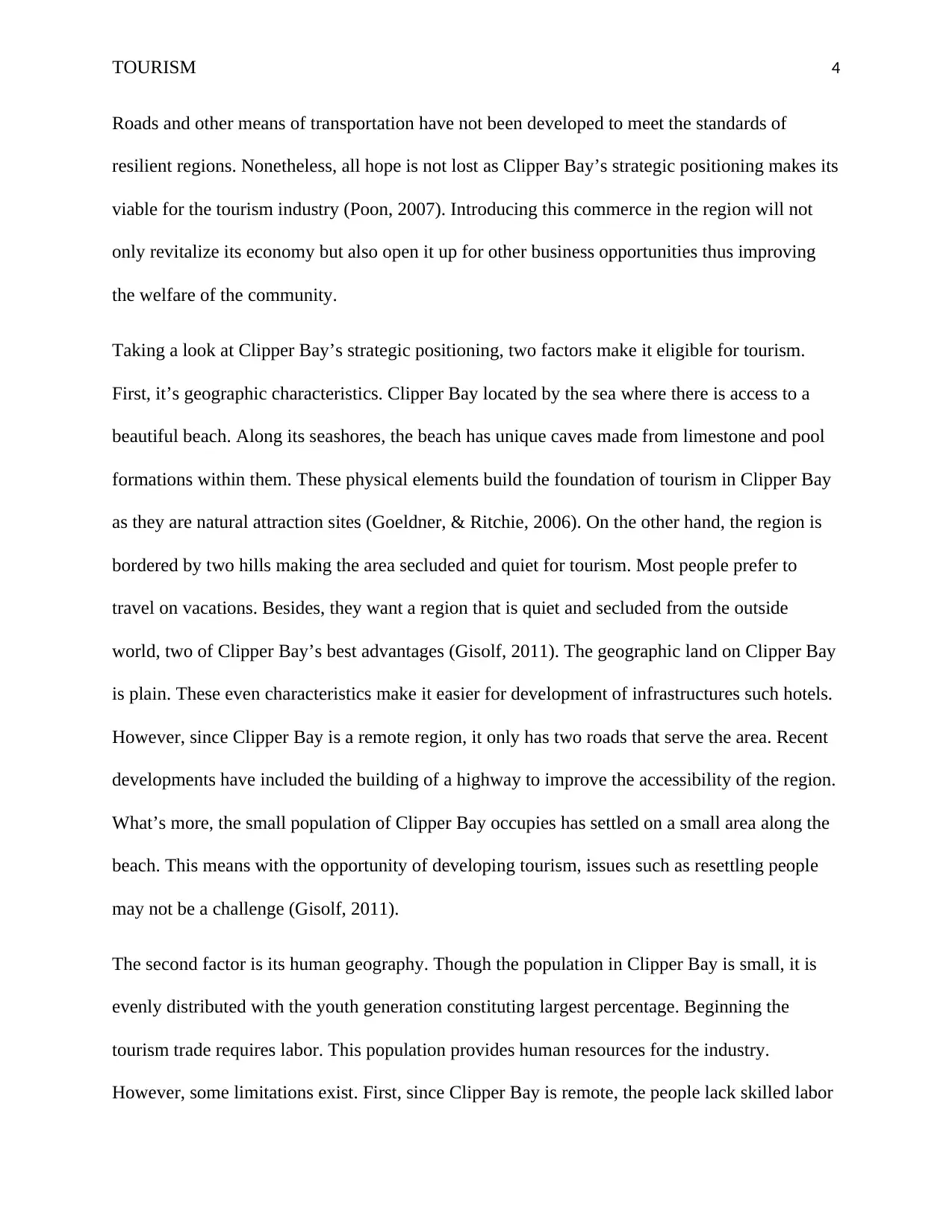
TOURISM 4
Roads and other means of transportation have not been developed to meet the standards of
resilient regions. Nonetheless, all hope is not lost as Clipper Bay’s strategic positioning makes its
viable for the tourism industry (Poon, 2007). Introducing this commerce in the region will not
only revitalize its economy but also open it up for other business opportunities thus improving
the welfare of the community.
Taking a look at Clipper Bay’s strategic positioning, two factors make it eligible for tourism.
First, it’s geographic characteristics. Clipper Bay located by the sea where there is access to a
beautiful beach. Along its seashores, the beach has unique caves made from limestone and pool
formations within them. These physical elements build the foundation of tourism in Clipper Bay
as they are natural attraction sites (Goeldner, & Ritchie, 2006). On the other hand, the region is
bordered by two hills making the area secluded and quiet for tourism. Most people prefer to
travel on vacations. Besides, they want a region that is quiet and secluded from the outside
world, two of Clipper Bay’s best advantages (Gisolf, 2011). The geographic land on Clipper Bay
is plain. These even characteristics make it easier for development of infrastructures such hotels.
However, since Clipper Bay is a remote region, it only has two roads that serve the area. Recent
developments have included the building of a highway to improve the accessibility of the region.
What’s more, the small population of Clipper Bay occupies has settled on a small area along the
beach. This means with the opportunity of developing tourism, issues such as resettling people
may not be a challenge (Gisolf, 2011).
The second factor is its human geography. Though the population in Clipper Bay is small, it is
evenly distributed with the youth generation constituting largest percentage. Beginning the
tourism trade requires labor. This population provides human resources for the industry.
However, some limitations exist. First, since Clipper Bay is remote, the people lack skilled labor
Roads and other means of transportation have not been developed to meet the standards of
resilient regions. Nonetheless, all hope is not lost as Clipper Bay’s strategic positioning makes its
viable for the tourism industry (Poon, 2007). Introducing this commerce in the region will not
only revitalize its economy but also open it up for other business opportunities thus improving
the welfare of the community.
Taking a look at Clipper Bay’s strategic positioning, two factors make it eligible for tourism.
First, it’s geographic characteristics. Clipper Bay located by the sea where there is access to a
beautiful beach. Along its seashores, the beach has unique caves made from limestone and pool
formations within them. These physical elements build the foundation of tourism in Clipper Bay
as they are natural attraction sites (Goeldner, & Ritchie, 2006). On the other hand, the region is
bordered by two hills making the area secluded and quiet for tourism. Most people prefer to
travel on vacations. Besides, they want a region that is quiet and secluded from the outside
world, two of Clipper Bay’s best advantages (Gisolf, 2011). The geographic land on Clipper Bay
is plain. These even characteristics make it easier for development of infrastructures such hotels.
However, since Clipper Bay is a remote region, it only has two roads that serve the area. Recent
developments have included the building of a highway to improve the accessibility of the region.
What’s more, the small population of Clipper Bay occupies has settled on a small area along the
beach. This means with the opportunity of developing tourism, issues such as resettling people
may not be a challenge (Gisolf, 2011).
The second factor is its human geography. Though the population in Clipper Bay is small, it is
evenly distributed with the youth generation constituting largest percentage. Beginning the
tourism trade requires labor. This population provides human resources for the industry.
However, some limitations exist. First, since Clipper Bay is remote, the people lack skilled labor
Paraphrase This Document
Need a fresh take? Get an instant paraphrase of this document with our AI Paraphraser
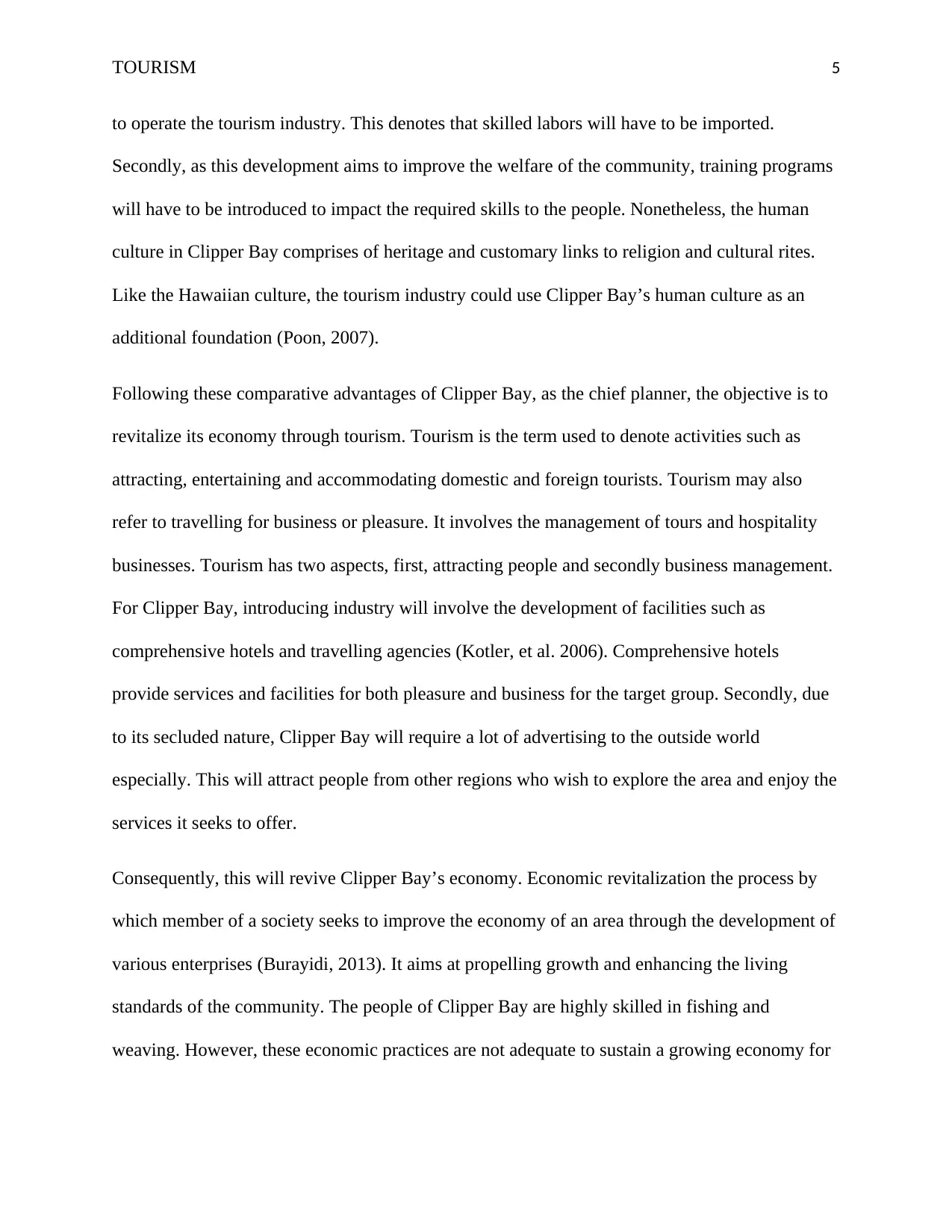
TOURISM 5
to operate the tourism industry. This denotes that skilled labors will have to be imported.
Secondly, as this development aims to improve the welfare of the community, training programs
will have to be introduced to impact the required skills to the people. Nonetheless, the human
culture in Clipper Bay comprises of heritage and customary links to religion and cultural rites.
Like the Hawaiian culture, the tourism industry could use Clipper Bay’s human culture as an
additional foundation (Poon, 2007).
Following these comparative advantages of Clipper Bay, as the chief planner, the objective is to
revitalize its economy through tourism. Tourism is the term used to denote activities such as
attracting, entertaining and accommodating domestic and foreign tourists. Tourism may also
refer to travelling for business or pleasure. It involves the management of tours and hospitality
businesses. Tourism has two aspects, first, attracting people and secondly business management.
For Clipper Bay, introducing industry will involve the development of facilities such as
comprehensive hotels and travelling agencies (Kotler, et al. 2006). Comprehensive hotels
provide services and facilities for both pleasure and business for the target group. Secondly, due
to its secluded nature, Clipper Bay will require a lot of advertising to the outside world
especially. This will attract people from other regions who wish to explore the area and enjoy the
services it seeks to offer.
Consequently, this will revive Clipper Bay’s economy. Economic revitalization the process by
which member of a society seeks to improve the economy of an area through the development of
various enterprises (Burayidi, 2013). It aims at propelling growth and enhancing the living
standards of the community. The people of Clipper Bay are highly skilled in fishing and
weaving. However, these economic practices are not adequate to sustain a growing economy for
to operate the tourism industry. This denotes that skilled labors will have to be imported.
Secondly, as this development aims to improve the welfare of the community, training programs
will have to be introduced to impact the required skills to the people. Nonetheless, the human
culture in Clipper Bay comprises of heritage and customary links to religion and cultural rites.
Like the Hawaiian culture, the tourism industry could use Clipper Bay’s human culture as an
additional foundation (Poon, 2007).
Following these comparative advantages of Clipper Bay, as the chief planner, the objective is to
revitalize its economy through tourism. Tourism is the term used to denote activities such as
attracting, entertaining and accommodating domestic and foreign tourists. Tourism may also
refer to travelling for business or pleasure. It involves the management of tours and hospitality
businesses. Tourism has two aspects, first, attracting people and secondly business management.
For Clipper Bay, introducing industry will involve the development of facilities such as
comprehensive hotels and travelling agencies (Kotler, et al. 2006). Comprehensive hotels
provide services and facilities for both pleasure and business for the target group. Secondly, due
to its secluded nature, Clipper Bay will require a lot of advertising to the outside world
especially. This will attract people from other regions who wish to explore the area and enjoy the
services it seeks to offer.
Consequently, this will revive Clipper Bay’s economy. Economic revitalization the process by
which member of a society seeks to improve the economy of an area through the development of
various enterprises (Burayidi, 2013). It aims at propelling growth and enhancing the living
standards of the community. The people of Clipper Bay are highly skilled in fishing and
weaving. However, these economic practices are not adequate to sustain a growing economy for
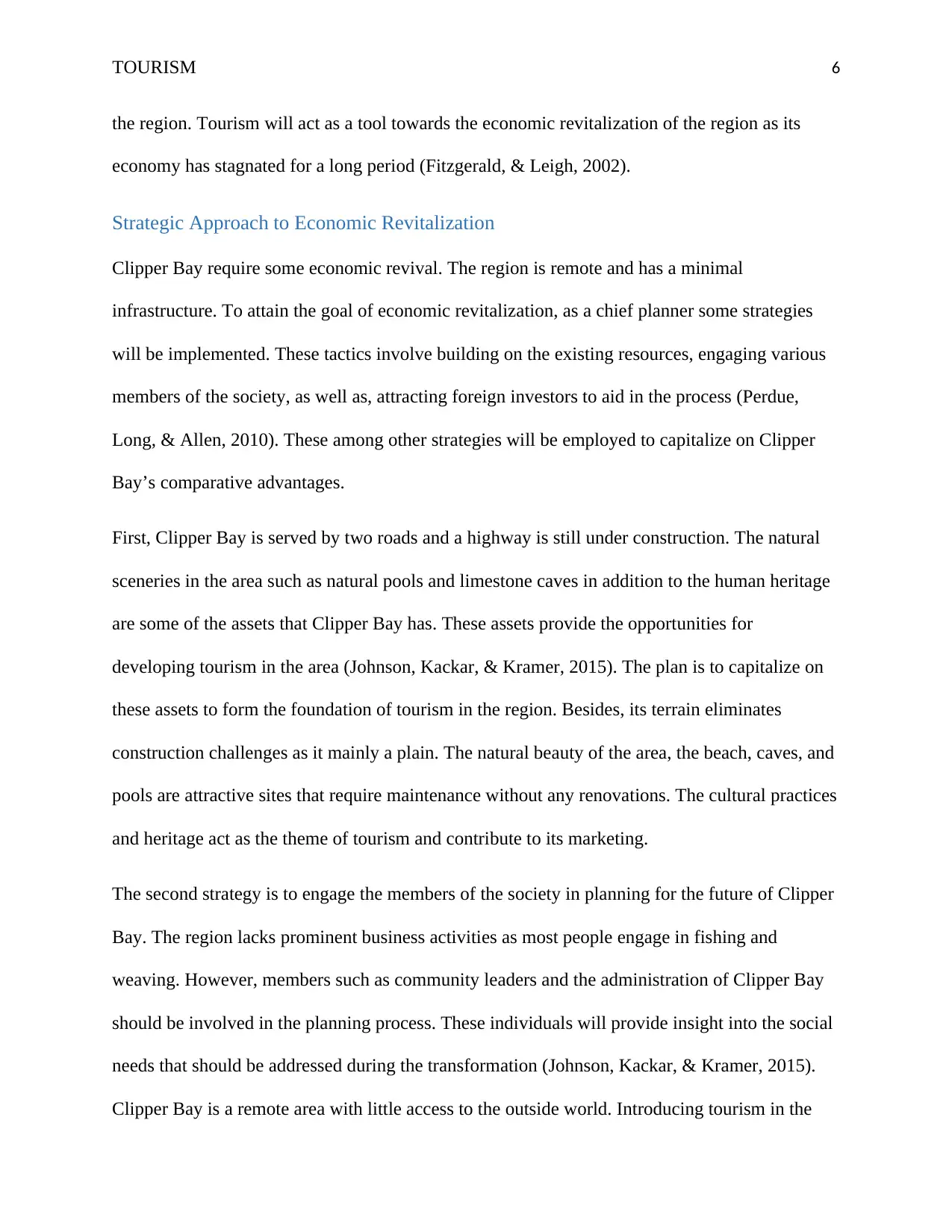
TOURISM 6
the region. Tourism will act as a tool towards the economic revitalization of the region as its
economy has stagnated for a long period (Fitzgerald, & Leigh, 2002).
Strategic Approach to Economic Revitalization
Clipper Bay require some economic revival. The region is remote and has a minimal
infrastructure. To attain the goal of economic revitalization, as a chief planner some strategies
will be implemented. These tactics involve building on the existing resources, engaging various
members of the society, as well as, attracting foreign investors to aid in the process (Perdue,
Long, & Allen, 2010). These among other strategies will be employed to capitalize on Clipper
Bay’s comparative advantages.
First, Clipper Bay is served by two roads and a highway is still under construction. The natural
sceneries in the area such as natural pools and limestone caves in addition to the human heritage
are some of the assets that Clipper Bay has. These assets provide the opportunities for
developing tourism in the area (Johnson, Kackar, & Kramer, 2015). The plan is to capitalize on
these assets to form the foundation of tourism in the region. Besides, its terrain eliminates
construction challenges as it mainly a plain. The natural beauty of the area, the beach, caves, and
pools are attractive sites that require maintenance without any renovations. The cultural practices
and heritage act as the theme of tourism and contribute to its marketing.
The second strategy is to engage the members of the society in planning for the future of Clipper
Bay. The region lacks prominent business activities as most people engage in fishing and
weaving. However, members such as community leaders and the administration of Clipper Bay
should be involved in the planning process. These individuals will provide insight into the social
needs that should be addressed during the transformation (Johnson, Kackar, & Kramer, 2015).
Clipper Bay is a remote area with little access to the outside world. Introducing tourism in the
the region. Tourism will act as a tool towards the economic revitalization of the region as its
economy has stagnated for a long period (Fitzgerald, & Leigh, 2002).
Strategic Approach to Economic Revitalization
Clipper Bay require some economic revival. The region is remote and has a minimal
infrastructure. To attain the goal of economic revitalization, as a chief planner some strategies
will be implemented. These tactics involve building on the existing resources, engaging various
members of the society, as well as, attracting foreign investors to aid in the process (Perdue,
Long, & Allen, 2010). These among other strategies will be employed to capitalize on Clipper
Bay’s comparative advantages.
First, Clipper Bay is served by two roads and a highway is still under construction. The natural
sceneries in the area such as natural pools and limestone caves in addition to the human heritage
are some of the assets that Clipper Bay has. These assets provide the opportunities for
developing tourism in the area (Johnson, Kackar, & Kramer, 2015). The plan is to capitalize on
these assets to form the foundation of tourism in the region. Besides, its terrain eliminates
construction challenges as it mainly a plain. The natural beauty of the area, the beach, caves, and
pools are attractive sites that require maintenance without any renovations. The cultural practices
and heritage act as the theme of tourism and contribute to its marketing.
The second strategy is to engage the members of the society in planning for the future of Clipper
Bay. The region lacks prominent business activities as most people engage in fishing and
weaving. However, members such as community leaders and the administration of Clipper Bay
should be involved in the planning process. These individuals will provide insight into the social
needs that should be addressed during the transformation (Johnson, Kackar, & Kramer, 2015).
Clipper Bay is a remote area with little access to the outside world. Introducing tourism in the
⊘ This is a preview!⊘
Do you want full access?
Subscribe today to unlock all pages.

Trusted by 1+ million students worldwide

TOURISM 7
territory may instigate some level of resistance. Engaging community leaders and the governing
body will help in generating public support for the changes and creating a momentum for
executing the changes (Ewalt, Freeman, & Poole, 2008). Thirdly, the provided budget may not
be adequate to implement the intended plans. It is necessary to attract domestic and outside
investors who may wish to take advantage of the opportunities that Clipper Bay presents. This
will enhance local and foreign interest, community commitment and entice private investment. It
will also provide additional funding.
Nevertheless, tourism is an industry that has been associated with environmental degradation. It
is apparent that most of Clipper Bay terrain will be affected by the new changes. Some land will
be set aside for the construction of hospitality facilities and construction of roads that enable
accessibility. This will require restructuring the plain lands of Clipper Bay. Additionally, with
the proposed tourism plans, new investors in other fields may seek to develop businesses in the
region. This will result in environmental pollution affecting the ecological systems and marine
life. As such, strategies that support a healthy and clean environment will be implemented
(Weaver, Lawton, & De Lacy, 2009). First, natural resources should be protected by providing
finances for their maintenance, for instance, the pools. Secondly, developing a drainage system
that limits the pollution of the sea and its effect on the marine life. The aim is to minimize
environmental contamination and utilize the available resources productively (Johnson, Kackar,
& Kramer, 2015).
These strategies will be utilized in destination management. Engaging community leaders and
the government provide additional insights and collaborative planning to ensure that the needs of
the society are incorporated (World Tourism Organization UNWTO. 2017). Secondly,
information and evidence should be gathered to ensure that the proposed plans are viable. The
territory may instigate some level of resistance. Engaging community leaders and the governing
body will help in generating public support for the changes and creating a momentum for
executing the changes (Ewalt, Freeman, & Poole, 2008). Thirdly, the provided budget may not
be adequate to implement the intended plans. It is necessary to attract domestic and outside
investors who may wish to take advantage of the opportunities that Clipper Bay presents. This
will enhance local and foreign interest, community commitment and entice private investment. It
will also provide additional funding.
Nevertheless, tourism is an industry that has been associated with environmental degradation. It
is apparent that most of Clipper Bay terrain will be affected by the new changes. Some land will
be set aside for the construction of hospitality facilities and construction of roads that enable
accessibility. This will require restructuring the plain lands of Clipper Bay. Additionally, with
the proposed tourism plans, new investors in other fields may seek to develop businesses in the
region. This will result in environmental pollution affecting the ecological systems and marine
life. As such, strategies that support a healthy and clean environment will be implemented
(Weaver, Lawton, & De Lacy, 2009). First, natural resources should be protected by providing
finances for their maintenance, for instance, the pools. Secondly, developing a drainage system
that limits the pollution of the sea and its effect on the marine life. The aim is to minimize
environmental contamination and utilize the available resources productively (Johnson, Kackar,
& Kramer, 2015).
These strategies will be utilized in destination management. Engaging community leaders and
the government provide additional insights and collaborative planning to ensure that the needs of
the society are incorporated (World Tourism Organization UNWTO. 2017). Secondly,
information and evidence should be gathered to ensure that the proposed plans are viable. The
Paraphrase This Document
Need a fresh take? Get an instant paraphrase of this document with our AI Paraphraser
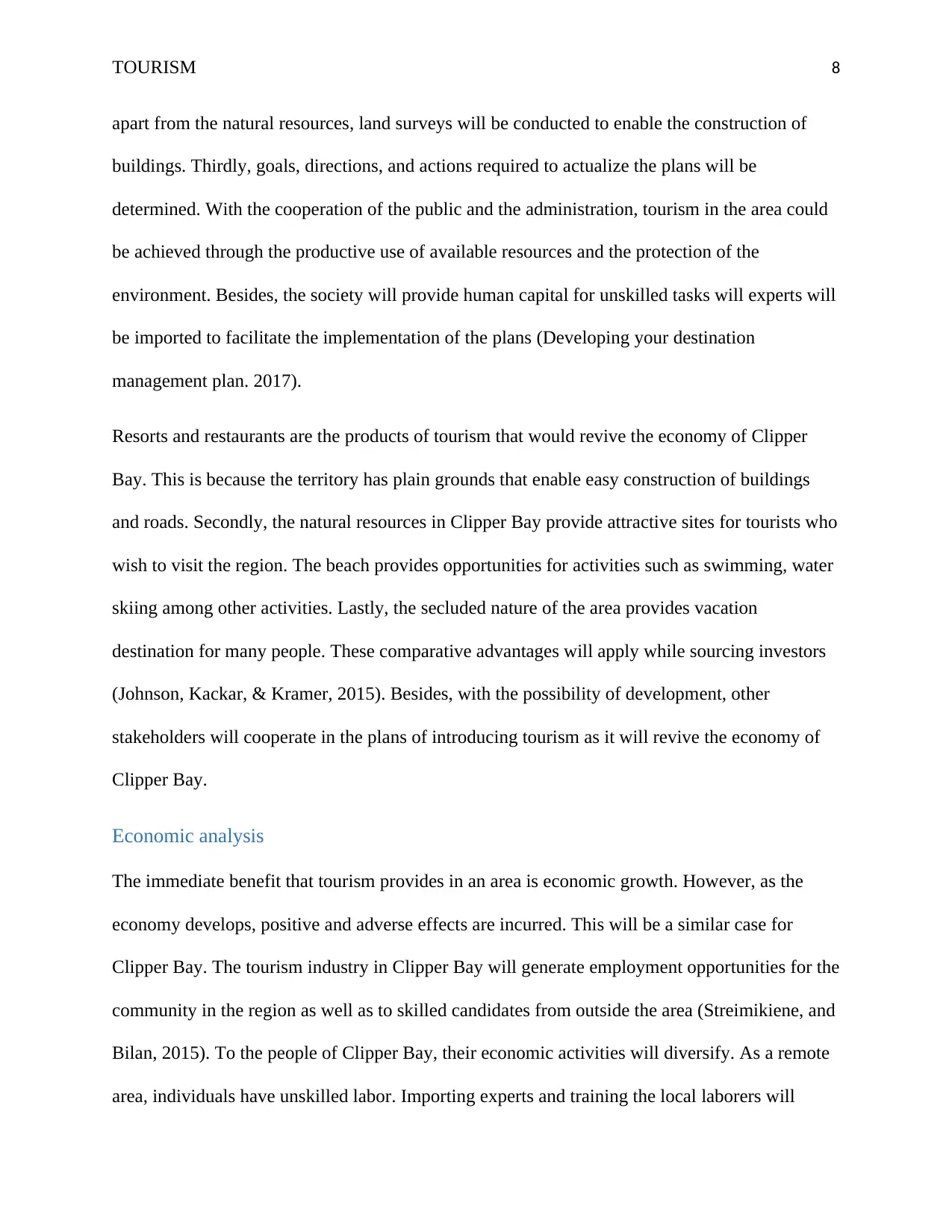
TOURISM 8
apart from the natural resources, land surveys will be conducted to enable the construction of
buildings. Thirdly, goals, directions, and actions required to actualize the plans will be
determined. With the cooperation of the public and the administration, tourism in the area could
be achieved through the productive use of available resources and the protection of the
environment. Besides, the society will provide human capital for unskilled tasks will experts will
be imported to facilitate the implementation of the plans (Developing your destination
management plan. 2017).
Resorts and restaurants are the products of tourism that would revive the economy of Clipper
Bay. This is because the territory has plain grounds that enable easy construction of buildings
and roads. Secondly, the natural resources in Clipper Bay provide attractive sites for tourists who
wish to visit the region. The beach provides opportunities for activities such as swimming, water
skiing among other activities. Lastly, the secluded nature of the area provides vacation
destination for many people. These comparative advantages will apply while sourcing investors
(Johnson, Kackar, & Kramer, 2015). Besides, with the possibility of development, other
stakeholders will cooperate in the plans of introducing tourism as it will revive the economy of
Clipper Bay.
Economic analysis
The immediate benefit that tourism provides in an area is economic growth. However, as the
economy develops, positive and adverse effects are incurred. This will be a similar case for
Clipper Bay. The tourism industry in Clipper Bay will generate employment opportunities for the
community in the region as well as to skilled candidates from outside the area (Streimikiene, and
Bilan, 2015). To the people of Clipper Bay, their economic activities will diversify. As a remote
area, individuals have unskilled labor. Importing experts and training the local laborers will
apart from the natural resources, land surveys will be conducted to enable the construction of
buildings. Thirdly, goals, directions, and actions required to actualize the plans will be
determined. With the cooperation of the public and the administration, tourism in the area could
be achieved through the productive use of available resources and the protection of the
environment. Besides, the society will provide human capital for unskilled tasks will experts will
be imported to facilitate the implementation of the plans (Developing your destination
management plan. 2017).
Resorts and restaurants are the products of tourism that would revive the economy of Clipper
Bay. This is because the territory has plain grounds that enable easy construction of buildings
and roads. Secondly, the natural resources in Clipper Bay provide attractive sites for tourists who
wish to visit the region. The beach provides opportunities for activities such as swimming, water
skiing among other activities. Lastly, the secluded nature of the area provides vacation
destination for many people. These comparative advantages will apply while sourcing investors
(Johnson, Kackar, & Kramer, 2015). Besides, with the possibility of development, other
stakeholders will cooperate in the plans of introducing tourism as it will revive the economy of
Clipper Bay.
Economic analysis
The immediate benefit that tourism provides in an area is economic growth. However, as the
economy develops, positive and adverse effects are incurred. This will be a similar case for
Clipper Bay. The tourism industry in Clipper Bay will generate employment opportunities for the
community in the region as well as to skilled candidates from outside the area (Streimikiene, and
Bilan, 2015). To the people of Clipper Bay, their economic activities will diversify. As a remote
area, individuals have unskilled labor. Importing experts and training the local laborers will
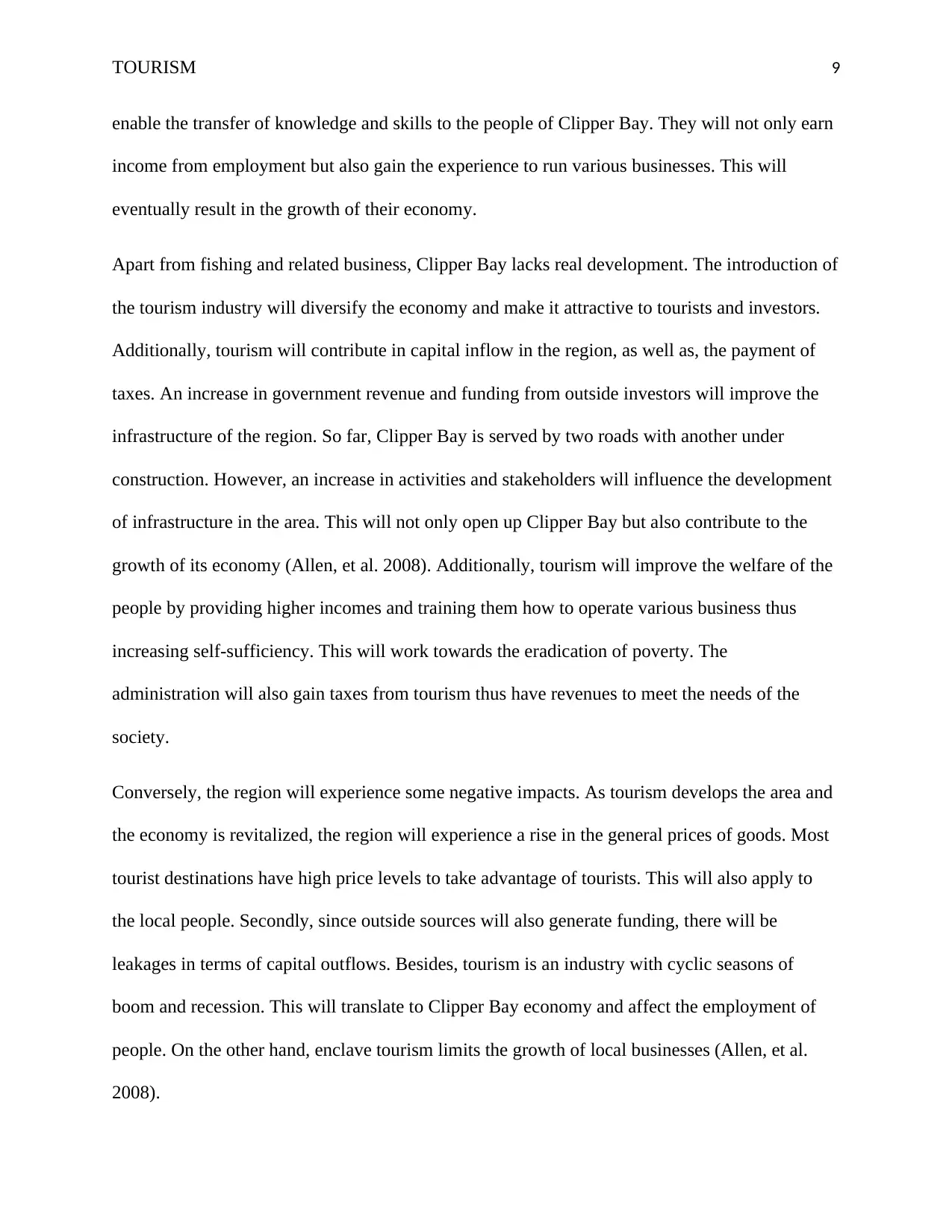
TOURISM 9
enable the transfer of knowledge and skills to the people of Clipper Bay. They will not only earn
income from employment but also gain the experience to run various businesses. This will
eventually result in the growth of their economy.
Apart from fishing and related business, Clipper Bay lacks real development. The introduction of
the tourism industry will diversify the economy and make it attractive to tourists and investors.
Additionally, tourism will contribute in capital inflow in the region, as well as, the payment of
taxes. An increase in government revenue and funding from outside investors will improve the
infrastructure of the region. So far, Clipper Bay is served by two roads with another under
construction. However, an increase in activities and stakeholders will influence the development
of infrastructure in the area. This will not only open up Clipper Bay but also contribute to the
growth of its economy (Allen, et al. 2008). Additionally, tourism will improve the welfare of the
people by providing higher incomes and training them how to operate various business thus
increasing self-sufficiency. This will work towards the eradication of poverty. The
administration will also gain taxes from tourism thus have revenues to meet the needs of the
society.
Conversely, the region will experience some negative impacts. As tourism develops the area and
the economy is revitalized, the region will experience a rise in the general prices of goods. Most
tourist destinations have high price levels to take advantage of tourists. This will also apply to
the local people. Secondly, since outside sources will also generate funding, there will be
leakages in terms of capital outflows. Besides, tourism is an industry with cyclic seasons of
boom and recession. This will translate to Clipper Bay economy and affect the employment of
people. On the other hand, enclave tourism limits the growth of local businesses (Allen, et al.
2008).
enable the transfer of knowledge and skills to the people of Clipper Bay. They will not only earn
income from employment but also gain the experience to run various businesses. This will
eventually result in the growth of their economy.
Apart from fishing and related business, Clipper Bay lacks real development. The introduction of
the tourism industry will diversify the economy and make it attractive to tourists and investors.
Additionally, tourism will contribute in capital inflow in the region, as well as, the payment of
taxes. An increase in government revenue and funding from outside investors will improve the
infrastructure of the region. So far, Clipper Bay is served by two roads with another under
construction. However, an increase in activities and stakeholders will influence the development
of infrastructure in the area. This will not only open up Clipper Bay but also contribute to the
growth of its economy (Allen, et al. 2008). Additionally, tourism will improve the welfare of the
people by providing higher incomes and training them how to operate various business thus
increasing self-sufficiency. This will work towards the eradication of poverty. The
administration will also gain taxes from tourism thus have revenues to meet the needs of the
society.
Conversely, the region will experience some negative impacts. As tourism develops the area and
the economy is revitalized, the region will experience a rise in the general prices of goods. Most
tourist destinations have high price levels to take advantage of tourists. This will also apply to
the local people. Secondly, since outside sources will also generate funding, there will be
leakages in terms of capital outflows. Besides, tourism is an industry with cyclic seasons of
boom and recession. This will translate to Clipper Bay economy and affect the employment of
people. On the other hand, enclave tourism limits the growth of local businesses (Allen, et al.
2008).
⊘ This is a preview!⊘
Do you want full access?
Subscribe today to unlock all pages.

Trusted by 1+ million students worldwide
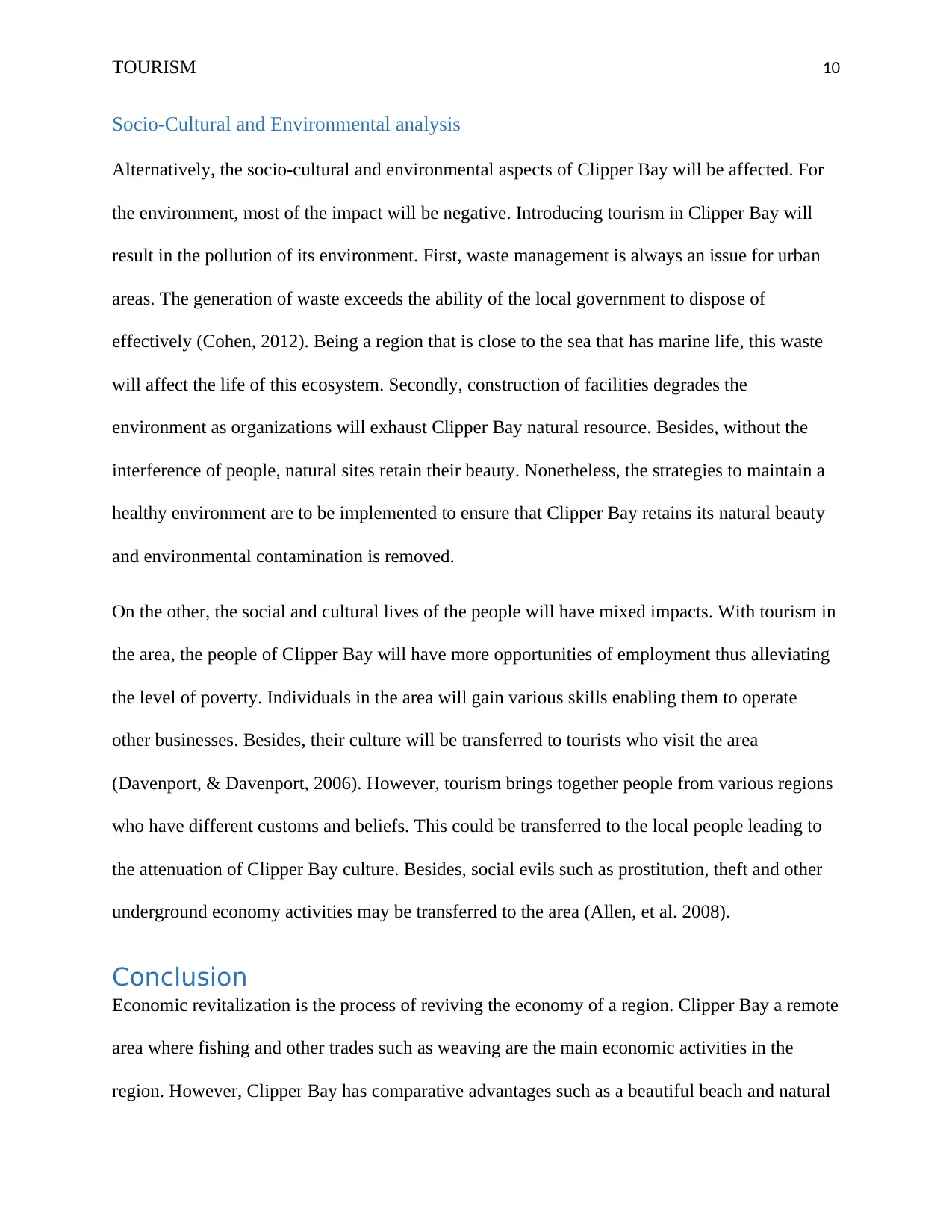
TOURISM 10
Socio-Cultural and Environmental analysis
Alternatively, the socio-cultural and environmental aspects of Clipper Bay will be affected. For
the environment, most of the impact will be negative. Introducing tourism in Clipper Bay will
result in the pollution of its environment. First, waste management is always an issue for urban
areas. The generation of waste exceeds the ability of the local government to dispose of
effectively (Cohen, 2012). Being a region that is close to the sea that has marine life, this waste
will affect the life of this ecosystem. Secondly, construction of facilities degrades the
environment as organizations will exhaust Clipper Bay natural resource. Besides, without the
interference of people, natural sites retain their beauty. Nonetheless, the strategies to maintain a
healthy environment are to be implemented to ensure that Clipper Bay retains its natural beauty
and environmental contamination is removed.
On the other, the social and cultural lives of the people will have mixed impacts. With tourism in
the area, the people of Clipper Bay will have more opportunities of employment thus alleviating
the level of poverty. Individuals in the area will gain various skills enabling them to operate
other businesses. Besides, their culture will be transferred to tourists who visit the area
(Davenport, & Davenport, 2006). However, tourism brings together people from various regions
who have different customs and beliefs. This could be transferred to the local people leading to
the attenuation of Clipper Bay culture. Besides, social evils such as prostitution, theft and other
underground economy activities may be transferred to the area (Allen, et al. 2008).
Conclusion
Economic revitalization is the process of reviving the economy of a region. Clipper Bay a remote
area where fishing and other trades such as weaving are the main economic activities in the
region. However, Clipper Bay has comparative advantages such as a beautiful beach and natural
Socio-Cultural and Environmental analysis
Alternatively, the socio-cultural and environmental aspects of Clipper Bay will be affected. For
the environment, most of the impact will be negative. Introducing tourism in Clipper Bay will
result in the pollution of its environment. First, waste management is always an issue for urban
areas. The generation of waste exceeds the ability of the local government to dispose of
effectively (Cohen, 2012). Being a region that is close to the sea that has marine life, this waste
will affect the life of this ecosystem. Secondly, construction of facilities degrades the
environment as organizations will exhaust Clipper Bay natural resource. Besides, without the
interference of people, natural sites retain their beauty. Nonetheless, the strategies to maintain a
healthy environment are to be implemented to ensure that Clipper Bay retains its natural beauty
and environmental contamination is removed.
On the other, the social and cultural lives of the people will have mixed impacts. With tourism in
the area, the people of Clipper Bay will have more opportunities of employment thus alleviating
the level of poverty. Individuals in the area will gain various skills enabling them to operate
other businesses. Besides, their culture will be transferred to tourists who visit the area
(Davenport, & Davenport, 2006). However, tourism brings together people from various regions
who have different customs and beliefs. This could be transferred to the local people leading to
the attenuation of Clipper Bay culture. Besides, social evils such as prostitution, theft and other
underground economy activities may be transferred to the area (Allen, et al. 2008).
Conclusion
Economic revitalization is the process of reviving the economy of a region. Clipper Bay a remote
area where fishing and other trades such as weaving are the main economic activities in the
region. However, Clipper Bay has comparative advantages such as a beautiful beach and natural
Paraphrase This Document
Need a fresh take? Get an instant paraphrase of this document with our AI Paraphraser
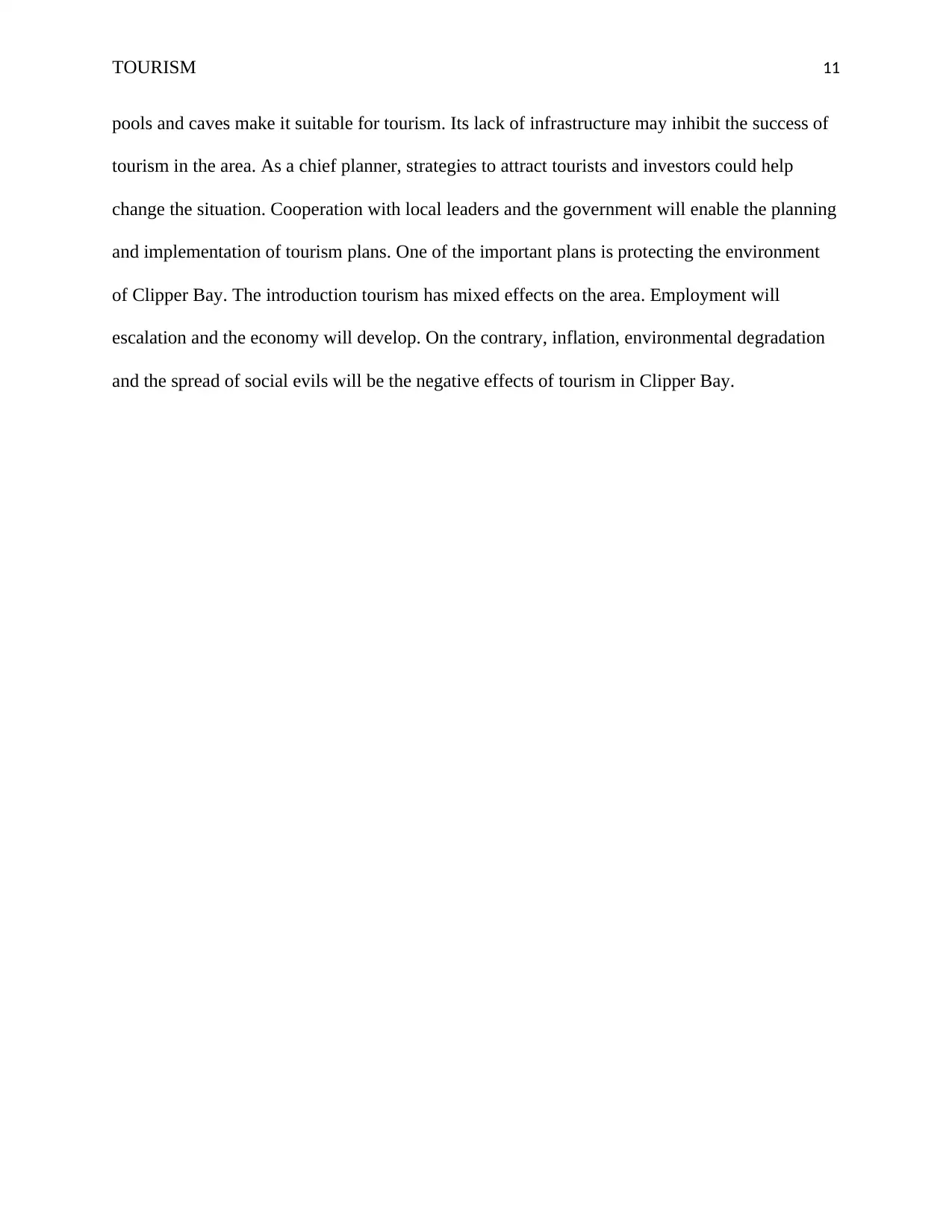
TOURISM 11
pools and caves make it suitable for tourism. Its lack of infrastructure may inhibit the success of
tourism in the area. As a chief planner, strategies to attract tourists and investors could help
change the situation. Cooperation with local leaders and the government will enable the planning
and implementation of tourism plans. One of the important plans is protecting the environment
of Clipper Bay. The introduction tourism has mixed effects on the area. Employment will
escalation and the economy will develop. On the contrary, inflation, environmental degradation
and the spread of social evils will be the negative effects of tourism in Clipper Bay.
pools and caves make it suitable for tourism. Its lack of infrastructure may inhibit the success of
tourism in the area. As a chief planner, strategies to attract tourists and investors could help
change the situation. Cooperation with local leaders and the government will enable the planning
and implementation of tourism plans. One of the important plans is protecting the environment
of Clipper Bay. The introduction tourism has mixed effects on the area. Employment will
escalation and the economy will develop. On the contrary, inflation, environmental degradation
and the spread of social evils will be the negative effects of tourism in Clipper Bay.
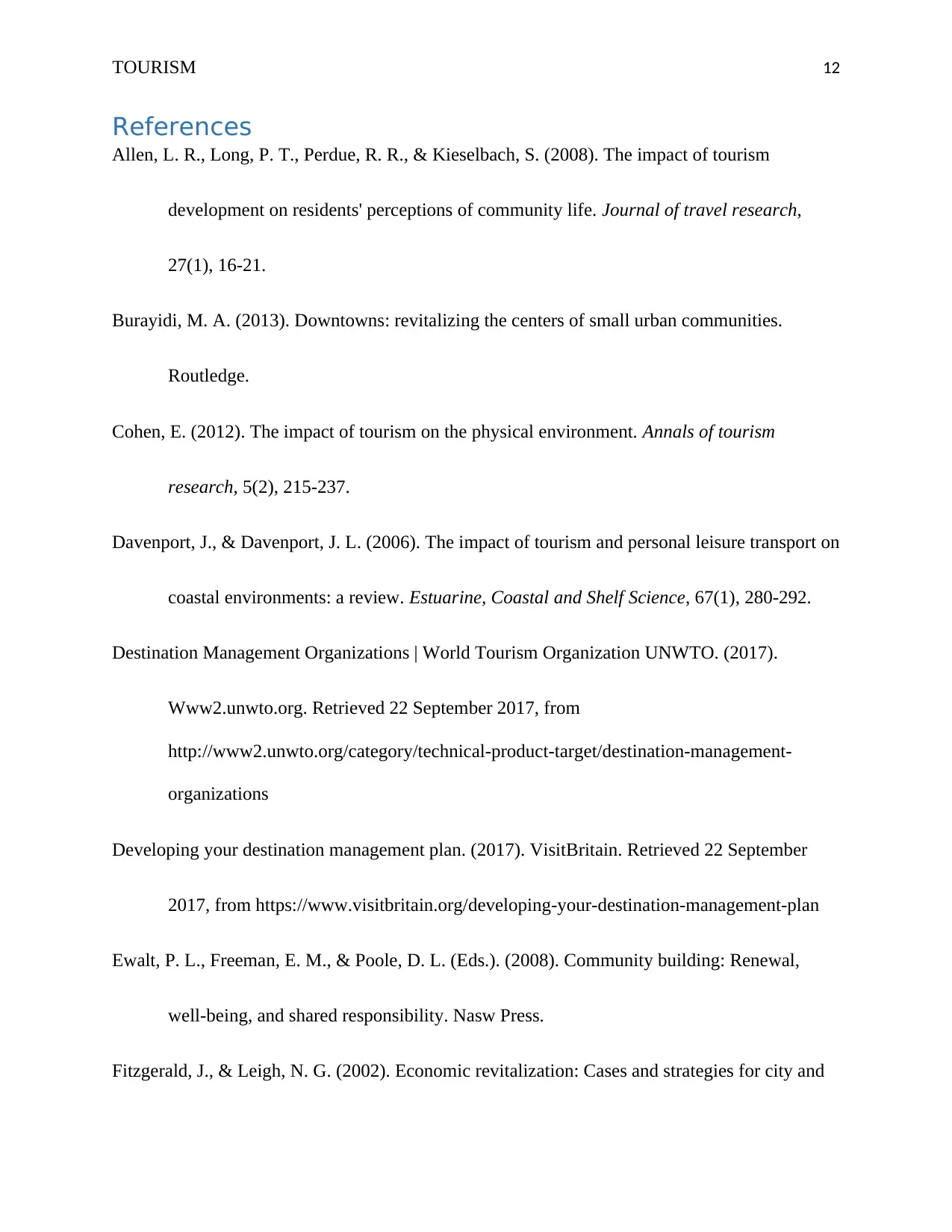
TOURISM 12
References
Allen, L. R., Long, P. T., Perdue, R. R., & Kieselbach, S. (2008). The impact of tourism
development on residents' perceptions of community life. Journal of travel research,
27(1), 16-21.
Burayidi, M. A. (2013). Downtowns: revitalizing the centers of small urban communities.
Routledge.
Cohen, E. (2012). The impact of tourism on the physical environment. Annals of tourism
research, 5(2), 215-237.
Davenport, J., & Davenport, J. L. (2006). The impact of tourism and personal leisure transport on
coastal environments: a review. Estuarine, Coastal and Shelf Science, 67(1), 280-292.
Destination Management Organizations | World Tourism Organization UNWTO. (2017).
Www2.unwto.org. Retrieved 22 September 2017, from
http://www2.unwto.org/category/technical-product-target/destination-management-
organizations
Developing your destination management plan. (2017). VisitBritain. Retrieved 22 September
2017, from https://www.visitbritain.org/developing-your-destination-management-plan
Ewalt, P. L., Freeman, E. M., & Poole, D. L. (Eds.). (2008). Community building: Renewal,
well-being, and shared responsibility. Nasw Press.
Fitzgerald, J., & Leigh, N. G. (2002). Economic revitalization: Cases and strategies for city and
References
Allen, L. R., Long, P. T., Perdue, R. R., & Kieselbach, S. (2008). The impact of tourism
development on residents' perceptions of community life. Journal of travel research,
27(1), 16-21.
Burayidi, M. A. (2013). Downtowns: revitalizing the centers of small urban communities.
Routledge.
Cohen, E. (2012). The impact of tourism on the physical environment. Annals of tourism
research, 5(2), 215-237.
Davenport, J., & Davenport, J. L. (2006). The impact of tourism and personal leisure transport on
coastal environments: a review. Estuarine, Coastal and Shelf Science, 67(1), 280-292.
Destination Management Organizations | World Tourism Organization UNWTO. (2017).
Www2.unwto.org. Retrieved 22 September 2017, from
http://www2.unwto.org/category/technical-product-target/destination-management-
organizations
Developing your destination management plan. (2017). VisitBritain. Retrieved 22 September
2017, from https://www.visitbritain.org/developing-your-destination-management-plan
Ewalt, P. L., Freeman, E. M., & Poole, D. L. (Eds.). (2008). Community building: Renewal,
well-being, and shared responsibility. Nasw Press.
Fitzgerald, J., & Leigh, N. G. (2002). Economic revitalization: Cases and strategies for city and
⊘ This is a preview!⊘
Do you want full access?
Subscribe today to unlock all pages.

Trusted by 1+ million students worldwide
1 out of 14
Related Documents
Your All-in-One AI-Powered Toolkit for Academic Success.
+13062052269
info@desklib.com
Available 24*7 on WhatsApp / Email
![[object Object]](/_next/static/media/star-bottom.7253800d.svg)
Unlock your academic potential
Copyright © 2020–2025 A2Z Services. All Rights Reserved. Developed and managed by ZUCOL.





